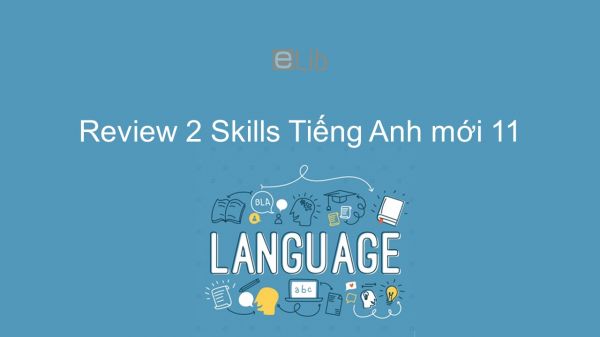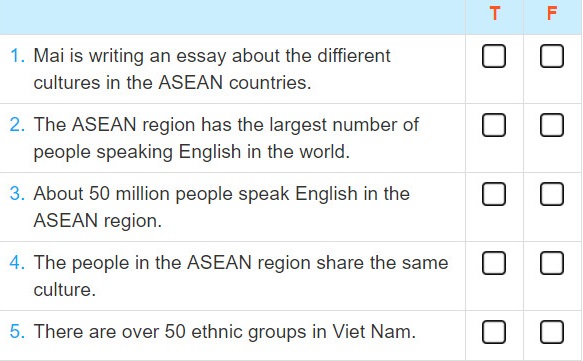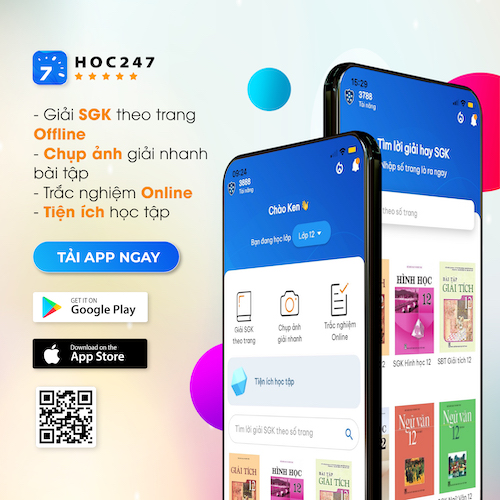Review 2 lớp 11 - Skills
Bài học Review 2 lớp 11 phần Skills hệ thống kiến thức đã học trong các Unit 4, 5 giúp các em ôn luyên các kĩ năng đọc hiểu, nói, nghe hiểu và viết. Mời các em cùng tham khảo!
Mục lục nội dung

Review 2 lớp 11 - Skills
1. Reading
1.1. Task 1 Review 2 lớp 11
a. Read the text (Đọc đoạn văn)
HOW TECHNOLOGY CAN HELP DISABLED PEOPLE TO LEAD A BETTER LIFE
Today, people with disabilities can lead a better life with the help of technology. Devices that help them to perform an activity are called assistive technology.
A telephone may not be attractive to persons with hearing impairments, but it can help them to send text messages over a phone line with the use of a teleprinter. This will enable them to send and receive messages like non-disabled people and communicate quickly and effectively.
People with visual impairments can have documents read out loud electronically on their computer. Speech recognition programmes allow people to give voice commands to their computer or have their words turned into print.
To make shared reading possible, children’s books can have both Braille and print text. This way, parents of a child with visual impairment can read the same book out loud while the child reads with fingers.
Tạm dịch:
Kỹ thuật có thể giúp người khuyết tật có cuộc sống tốt hơn như thế nào
Ngày nay, người khuyết tật có thể có cuộc sống tốt hơn nhờ sự giúp đỡ của kỹ thuật. Những thiết bị trợ giúp người khuyết tật thực hiện một hoạt động được gọi là kỹ thuật trợ giúp.
Một chiếc điện thoại có thể không hấp dẫn đối với những người khiếm thính nhưng lại có thể giúp họ gửi tin nhắn bằng đường điện thoại bằng việc sử dụng một chiếc máy chữ điện thoại. Điều này cho phép họ gửi và nhận tin nhắn giống những người bình thường và có thể giao tiếp nhanh và hiệu quả.
Những người khiếm thị lại có những văn bản đọc giọng điện tử trên máy tính. Những chương trình nhận dạng văn bản cho phép người ta đưa ra những yêu cầu về giọng nói cho máy tính hoặc yêu cầu chuyền từ qua dạng in.
Để làm cho việc đọc mang tính khả thi, sách trẻ em có thể có cả bảng chữ nổi Braille và văn bản in. Bằng cách này, cha mẹ của trẻ em khiếm thị có thể đọc to với các em cùng một cuốn sách cùng lúc với các em đọc bằng tay.
b. Match the words in A with their definitions in B. (Ghép từ ờ cột A với định nghĩa đúng ờ cột B.)
Guide to answer
1.a. assistive - a. giving assistance (trợ giúp - hỗ trợ )
2.d . teleprinter - d. a machine that prints messages written on a machine somewhere else and sent along telephone lines (máy điện báo - một máy in các tin nhắn viết trên một máy ở một nơi khác và gửi đi theo đường dây điện thoại.)
3.b. document - b. paper, form, book, etc. giving information about something; evidence or proof of something (tài liệu - giấy tờ, mẫu đơn, sổ sách... cung cấp thông tin về một thứ gì đó; bằng chứng hoặc chứng minh một cái gì đó.)
4.c. speech recognition - c. the ability of a machine to identify and respond to spoken language (nhận dạng giọng nói - khả năng của một máy tính để xác định và nhận diện ngôn ngữ nói.)
1.2. Task 2 Review 2 lớp 11
Answer the following questions. (Trả lời những câu hỏi dưới đây.)
1. What is assistive technology? (Công nghệ hỗ trợ là gì?)
2. How can people with hearing impairments communicate quickly? (Những người khiếm thính có thể giao tiếp nhanh như thế nào?)
3. How can visually impaired people 'read' documents? (Làm thế nào người khiếm thị có thể đọc 'tài liệu?')
4. Why should children's books be printed in both Braille and print text? (Tại sao sách của trẻ nên được in cả chữ nổi và chữ in?)
5. What can assistive technology do for people with disabilities? (Công nghệ hỗ trợ có thể giúp gì cho người khuyết tật?)
Guide to answer
1. Devices that help disabled people to perform an activity. (Các thiết bị có thể giúp người khuyết tật thực hiện 1 hoạt động.)
2. They can communicate quickly by sending and receiving messages. (Họ có thể giao tiếp nhanh bằng cách gửi và nhận tin nhắn.)
3. They can have documents read out loud electronically on their computer. (Họ có thể để tài liệu được đọc giọng điện tử trên máy tính.)
4. Children with visual impairment and their parents can read together/ share reading. (Trẻ em bị khiếm thị và bố mẹ của các em có thể đọc cùng nhau.)
5. It can improve the quality of life for people with disabilities. (Nó có thể cải thiện chất lượng cuộc sống cho những người khuyết tật.)
2. Speaking
2.1. Task 1 Review 2 lớp 11
Work in pairs. Read the information below. (Làm việc theo cặp. Đọc thông tin bên dưới.)
Universities in Singapore
• National University of Singapore (NUS)
– ranks 24th in the world (2013)
– subjects ranked within the top 10 worldwide: mechanical engineering, geography, law, computer science, accounting and finance, pharmacy, communication and media studies
• Nanyang Technological University (NTU)
– ranks in the top 50 in the world
– a lot of focus on research
– enrols undergraduate and postgraduate students in the colleges of engineering, business, science and humanities, arts & social sciences.
• Singapore University of Technology and Design
– a new university developed in partnership with Massachusetts Institute of Technology, USA, and Zhejiang University, China.
Tạm dịch:
Các trường đại học ở Singapore
• Đại học Quốc gia Singapore (NUS)
- đứng thứ 24 trên thế giới (2013)
- các môn học nằm trong top 10 trên toàn thế giới: kỹ thuật cơ khí, địa lý, luật, khoa học máy tính, kế toán và tài chính, dược phẩm, truyền thông và nghiên cứu phương tiện truyền thông
• Đại học Kỹ thuật Nanyang (NTU)
- đứng trong top 50 trên thế giới
- rất nhiều nghiên cứu tập trung
- Tuyển sinh đại học và sau đại học tại các trường kỹ thuật, kinh doanh, khoa học và nhân văn, nghệ thuật và khoa học xã hội.
• Đại học Công nghệ và Thiết kế Singapore
- một trường đại học mới được phát triển với sự hợp tác của Viện Công nghệ Massachusetts, Hoa Kỳ, và Đại học Chiết Giang, Trung Quốc.
2.2. Task 2 Review 2 lớp 11
Answer these questions. Discuss with a partner. (Trả lời những câu hỏi dưới đây. Thảo luận với bạn bên cạnh.)
1. Which university do you want to go? (Bạn muốn theo học trường đại học nào?)
2. Why do you want to study there? (Tại sao bạn muốn học ở đó?)
3. Listening
Listen to the conversation between Mr Long and his daughter Mai. Decidc whetba the following statements are true (T) or false (F). (Hãy nghe cuộc nói chuyện của ông Long và con gái Mai rồi quyết định xem những lời phát biểu dưới đây đúng (T) hay sai (F).)

Click to listen
Guide to answer
1 – T 2 – F 3 – T 4 – F 5 – T
Tạm dịch
1. Mai đang viết một bài tiểu luận về những nền văn hoá khác biệt ở các nước ASEAN.
2. Khu vực ASEAN có số lượng người nói tiếng Anh lớn nhất trên thế giới.
3. Khoảng 50 triệu người nói Tiếng Anh trong khu vực ASEAN.
4. Người dân trong khu vực ASEAN có chung một nền văn hoá.
5. Có hơn 50 nhóm dân tộc ở Việt Nam.
Audio Script
Mr Long: What are you doing, Mai? It's so late. Why don't you go to bed?
Mai: I'm trying to finish my essay about the different cultures in the ASEAN countries. I'll have to submit it tomorrow. Can I ask you a couple of questions, Dad?
Mr Long: Yes, go ahead. Hope I can help.
Mai: Do you know the number of people in South Asia who can speak English?
Mr Long: Ọuite a lot. The ASEAN region has the third largest number of English speakers, after the us and UK.
Mai: Really? So how many people speak English?
Mr Long: Around fifty million, I think,... mostly in the Philippines.
Mai: Fifty or fifteen?
Mr Long: Fifty.
Mai: There are more and more people learning English, especially in Viet Nam. The number is probably growing. Do you know anything about the different cultures.
Mr Long: The ASEAN countries have rich and diverse cultures. There are many ethal groups in the region.
Mai: What about Viet Nam, Dad?
Mr Long: Well, we have more than 50 ethnic groups in our country, and each has its language, lifestyle and culture.
Mai: I think I've got all the information I need for my essay. Thanks so much, Dai I
Mr Long: That's all right. Finish your essay and go to bed soon. I'm afraid you'll wake M late for school tomorrow morning.
Tạm dịch
Ông Long: Con đang làm gì, Mai? Đã muộn rồi. Tại sao con không đi ngủ?
Mai: Con đang cố gắng hoàn thành bài luận của con về các nền văn hóa khác nhau ở các quốc gia ASEAN. Con sẽ phải nộp nó vào ngày mai. Con có thể hỏi bố một vài câu hỏi không, bố?
Ông Long: Được, con hỏi đi. Hy vọng bố có thể giúp đỡ.
Mai: Bố có biết số người ở Nam Á có thể nói được tiếng Anh không?
Ông Long: Rất nhiều. Khu vực ASEAN có số lượng người nói tiếng Anh lớn thứ ba, sau Mỹ và Anh.
Mai: Thật sao? Vậy có bao nhiêu người nói được tiếng Anh?
Ông Long: Năm mươi triệu, Bố nghĩ vậy ... chủ yếu ở Philippines.
Mai: Năm mươi hay mười lăm?
Ông Long: Năm mươi.
Mai: Ngày càng có nhiều người học tiếng Anh, đặc biệt là ở Việt Nam. Con số này có lẽ đang tăng lên. Bố có biết gì về nền văn hoá khác nhau không?
Ông Long: Các nước ASEAN có nền văn hoá phong phú và đa dạng. Có nhiều nhóm người trong khu vực.
Mai: Còn Việt Nam thì sao, bố?
Ông Long: Chúng ta có hơn 50 dân tộc trên đất nước, và mỗi dân tộc có ngôn ngữ, lối sống và văn hoá riêng.
Mai: Con nghĩ rằng con có tất cả thông tin cần thiết cho bài luận của con rồi. Cảm ơn rất nhiều, bố.
Ông Long: Không có gì. Hoàn thành bài luận và đi ngủ sớm. Bố e rằng con sẽ dậy muộn vào buổi sáng mai.
4. Writing
Write an introduction to Thailand, using the facts below. Add more information, if necessary. (Hãy viết một bài giới thiệu về đất nước Thái Lan, sử dụng các thông tin dưới đây. Thêm thông tin nếu cần.)
Capital: Bangkok
Area: 513,120 km2
Official language: Thai
Population: (2014 estimate) 67,149,778
Currency: Thai baht
Ethnic groups: Thai (75%); Others: Chinese, Lao, Khmer
Economy: based on agri-food production; major exports: Thai rice, textile and footwear, fishery products and electronic products
Tourist attractions: Ko Tarutao and Ko Chang as beautiful islands, with sandy beaches and clean water; Ayuthaya as an old and beautiful city, with temples and palaces made of stone
Culture: shaped by many influences from Indian, Lao, Cambodian and Chinese cultures; famous festivals: Thai New Year (water fights) and Loy Kratong, a festival of lights and lanterns
Sports: very popular ‘Thai boxing’; others: rugby, golf, football, etc.
Guide to answer
THAILAND: INTRODUCTION
Thailand is one ASEAN member state which has a total area of 513,120 square kilomettres. Its capital is Bangkok. Thailand has a population of 67,149,778 (2014 estimated). The official language used in Thailand is Thai. Its currency is Thai baht. There are some ethnis groups living in Thailand: Chinese, Lao, and Khmer.
The economy of Thailand is based on agri-food production. Its major exports are Thai rice, textile and footwear, fishery products and electronic products.
There are a lot of tourist attractions in Thailand such as Ko Tarutao and Ko Chang, which are known as beautiful islands with sandy beaches and clean water. Ayuthaya is famous as an old and beautiful city, with temples and palaces made of stone.
Thai culture is shaped by many influences from Indian, Lao, Cambodian and Chinese cultures. The most famous festivals in Thailand are Thai New Year (known as water fights) and Loy Kratong, a festival of lights and lanterns.
Among the most popular sports in Thailand are Thai boxing, rugby, golf and football. Come and visit Thailand soon!
Tạm dịch:
Thái Lan là một quốc gia thành viên của ASEAN có tổng diện tích 513.120 km vuông. Thủ đô của nó là Bangkok. Thái Lan có dân số 67.149.778 người (ước tính năm 2014). Ngôn ngữ chính thức được sử dụng ở Thái Lan là tiếng Thái. Đồng tiền của nó là baht Thái Lan. Có một số nhóm dân tộc thiểu số sống ở Thái Lan: Trung Quốc, Lào và Khmer.
Nền kinh tế của Thái Lan dựa vào sản xuất nông nghiệp. Xuất khẩu chính là gạo Thái Lan, dệt may, giày dép, thủy sản và các sản phẩm điện tử.
Có rất nhiều điểm tham quan du lịch ở Thái Lan như Ko Tarutao và Ko Chang, được biết đến như những hòn đảo đẹp với những bãi biển đầy cát và nước trong. Ayuthaya nổi tiếng là một thành phố cổ kính và xinh đẹp, với đền thờ và cung điện bằng đá.
Văn hoá Thái được hình thành bởi nhiều ảnh hưởng từ văn hoá Ấn Độ, Lào, Campuchia và Trung Quốc. Các lễ hội nổi tiếng nhất ở Thái Lan là Thái Lan năm mới (được gọi là chiến đấu ở nước) và Loy Kratong, một lễ hội ánh đèn và đèn lồng.
Trong số các môn thể thao phổ biến nhất ở Thái Lan là môn quyền anh Thái, bóng bầu dục, sân golf và bóng đá. Hãy đến và ghé thăm Thái Lan sớm!
5. Practice Task 1
Mark the letter A, B, C, or D to indicate the sentence that is closest in meaning to each of the following questions.
Question 1: Last week, a team of foreign volunteers launched a campaign to help students with disabilities.
A. Last week, a team of foreign volunteers set up a campaign for students with disabilities to join in.
B. Last week, students with disabilities volunteered to launch a campaign with the help of a team of foreign volunteers.
C. Last week, both a team of foreign volunteers and students with disabilities launched a campaign.
D. Last week, a campaign was launched to help students with disabilities by a team of foreign volunteers.
Question 2: Two European philanthropists have spent more than a year walking from their continent to Asia to raise funds for needy children in Viet Nam
A. Funds were raised for needy children in Viet Nam by a one-year-walk from their continent to Asia by two European philanthropists.
B. In order to raise funds for needy children in Viet Nam, two European philanthropists have spent more than a year walking from their continent to Asia.
C. Two European philanthropists have been walking from their continent to Asia for more than a year because of needy children in Viet Nam.
D. Two European philanthropists walked from their continent to Asia more than a year ago to raise funds for needy children in Viet Nam.
6. Practice Task 2
Read the following passage and mark the letter A, B, C, or D on your answer sheet to indicate the correct answer to each of the questions
As a result, societies have difficult choices to make about the amount of effort and money they are willing to spend to save imperiled species. Will people accept limits on their property rights, recreational activities, and means of livelihood to save a plant or an animal? Should saving such popular species as whales and dolphins take priority over saving obscure, annoying, or fearful species? Is it the responsibility of humans to save every kind of life form from disappearing, or is extinction an inevitable part of nature, in which the strong survive and the weak perish? These are some difficult questions that people face as they ponder the fate of other species living on this planet.
Question 1: The changes in the system of benefits mean that ____.
A. anyone under twenty-five and not living at home will receive help with food and accommodation
B. the under twenty-fives can claim money only if they have left home
C. young people do not receive as much money as those over twenty-five
D. young people cannot claim money unless they are under sixteen or over twenty-five
Question 2: The word "permanent" in the last paragraph is closest in meaning to ____.
A. flexible B. obvious C. stable D. simple
7. Conclusion
Kết thúc bài học, các em cần luyện tập các kĩ năng sau:
- Luyện đọc và trả lời câu hỏi
- Luyện tập nói về một trường đại học
- Luyện nghe và chọn đáp án đúng
- Luyện viết một bài giới thiệu về một đất nước
Tham khảo thêm
- doc Review 2 lớp 11 - Language

